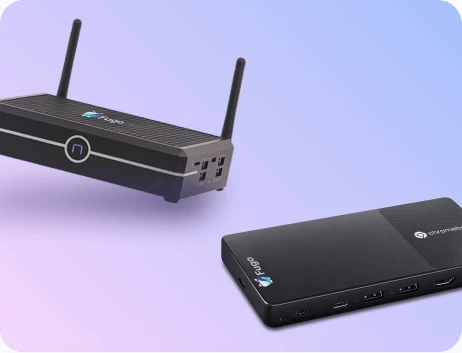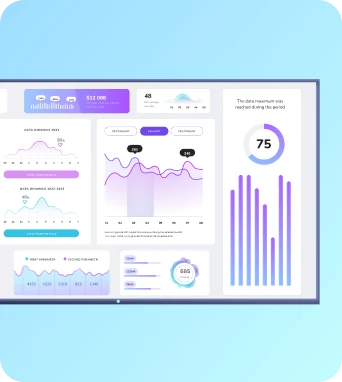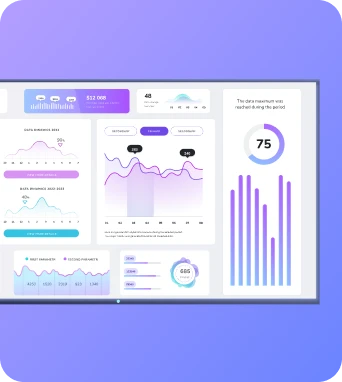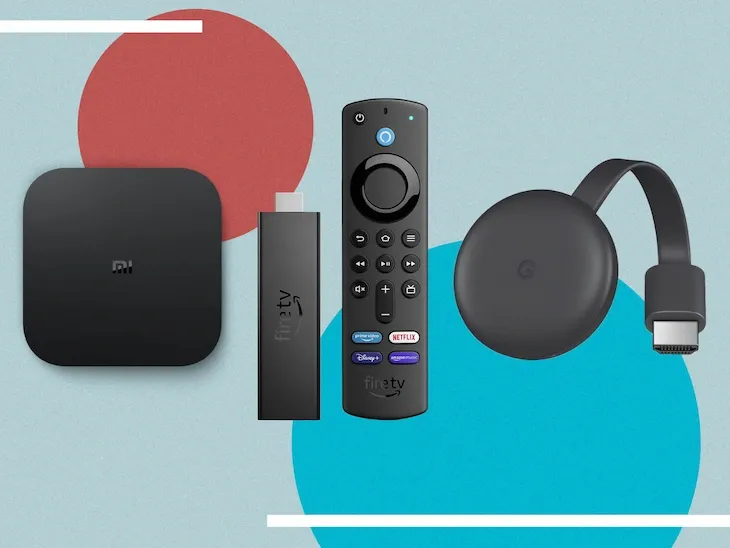The promise of Android for digital signage is compelling: affordable hardware, a familiar interface, and nearly limitless customization options. But if you’ve tried implementing Android signage, you’ve likely encountered the gap between those promises & reality.
Maybe your consumer-grade streaming stick overheated after a month of 24/7 use. Perhaps content scheduled via a basic media player app stopped updating after a network glitch. Or you’ve found yourself repeatedly rebooting frozen screens.
These are the challenges technical decision-makers face with Android digital signage. The right combination of hardware, software, and management tools is what separates a functional system from one that becomes a constant maintenance headache.
This guide offers practical insights on building reliable Android signage systems. We’ll explore the technical considerations that ensure your deployment succeeds, backed by lessons learned from hundreds of real-world installations across retail, corporate, hospitality, and education environments.
Understanding different Android variants for digital signage
When you’re planning your Android digital signage setup, you’ll come across three main types of Android operating systems: Standard Android, Android TV, and Android AOSP. While you might not be picking between these variants directly, the device you choose will determine which Android version it’s running. And that decision has a big impact on how your signage performs.
Here’s the rundown on how these Android variants power different devices and what that means for your digital signage:
Standard Android: powerful but complex
Standard Android is what you’ll find running on most smartphones & tablets.
This variant offers the full range of features, like access to the Google Play Store, background services, and the ability to run complex apps. For businesses that need flexibility, like self-service kiosks, interactive displays, or retail solutions, standard Android is a powerful choice.
However, the flexibility comes with some complexity. These devices weren’t originally designed to run 24/7 as signage, so you’ll need to make adjustments - locking down the interface, disabling unrelated apps, and configuring for single-purpose use.
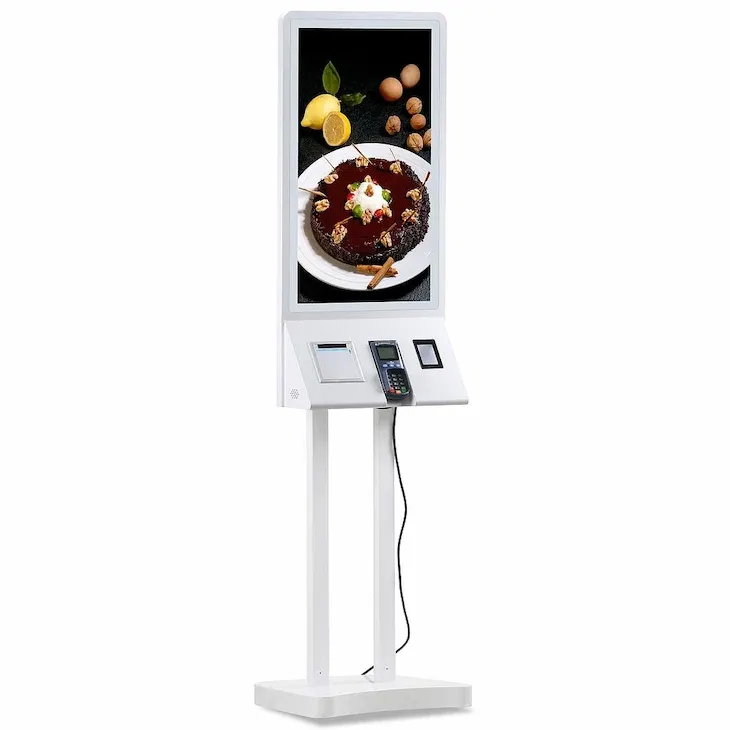
For instance, a restaurant using Android tablets for self-ordering can easily integrate with payment terminals or kitchen displays, but it will also need to ensure the devices stay on task and don’t get sidetracked by customers trying to access system settings.
Android TV: simple setup with limitations
Android TV is a simpler version of Android, built for smart TVs and streaming devices.
It’s optimized for media consumption, making it an easy choice for basic signage. Devices like the Google TV Streamer or Chromecast can be set up in minutes, and the user-friendly interface makes navigation a breeze.
But here’s the catch: Android TV’s focus on entertainment means it falls short when it comes to advanced signage needs. Professional deployments often require things like remote management, power scheduling, or system customization - features that Android TV just isn’t built to handle.
It’s also worth noting that Google TV, which runs on top of Android TV, offers a more polished interface with features like personalized recommendations, but it doesn’t change the core limitations of Android TV for professional signage use.
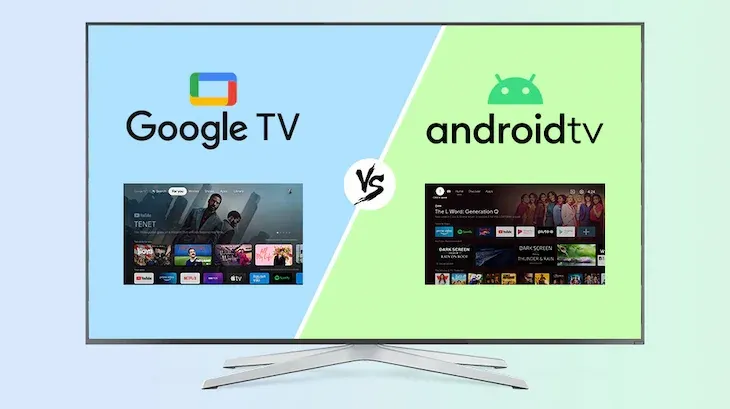
For example, if you’re deploying Google TV Streamers in a retail store, you’ll run into limitations when trying to implement things like automated power cycles or remote display adjustments.
Android AOSP: the foundation for professional signage
Android AOSP (Android Open Source Project) is the core operating system used in many commercial-grade signage devices. It gives manufacturers full control over how the device behaves, making it better for custom signage solutions that need tailored features like secure content display, remote management, and reliable 24/7 operation.
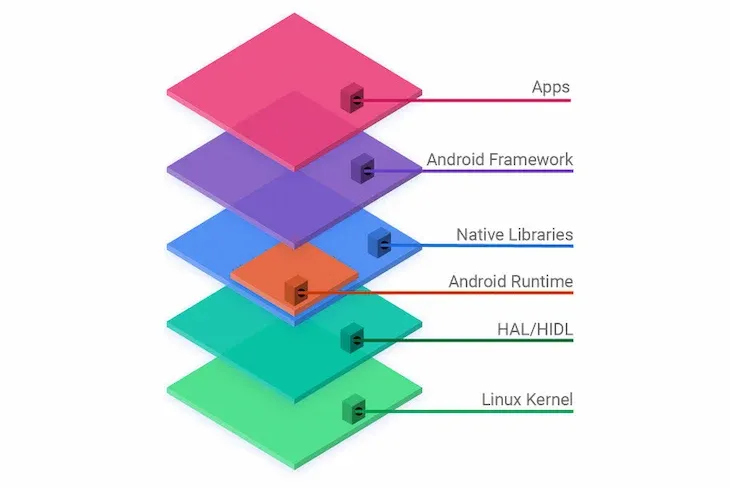
A good example of AOSP’s strengths can be found in retail chains or hotel lobbies, where digital kiosks or wayfinding displays are deployed.
For instance, a retail store may use AOSP-powered screens for interactive product displays that allow customers to browse product details or promotions. In these setups, AOSP ensures the device only runs the designated signage app, preventing access to other applications or system settings. It also enables automatic recovery from power failures, locking the device into signage mode, and providing features like remote monitoring to track device health.
While AOSP devices may cost more upfront, they are built for continuous operation and allow businesses to customize their signage systems in ways that standard Android or Android TV can’t.
🛍️ Already got your hardware? Then you're one step closer to getting started with content!
Start a trial & check out our Fugo 101 guide to see how to start pushing content & managing your device:
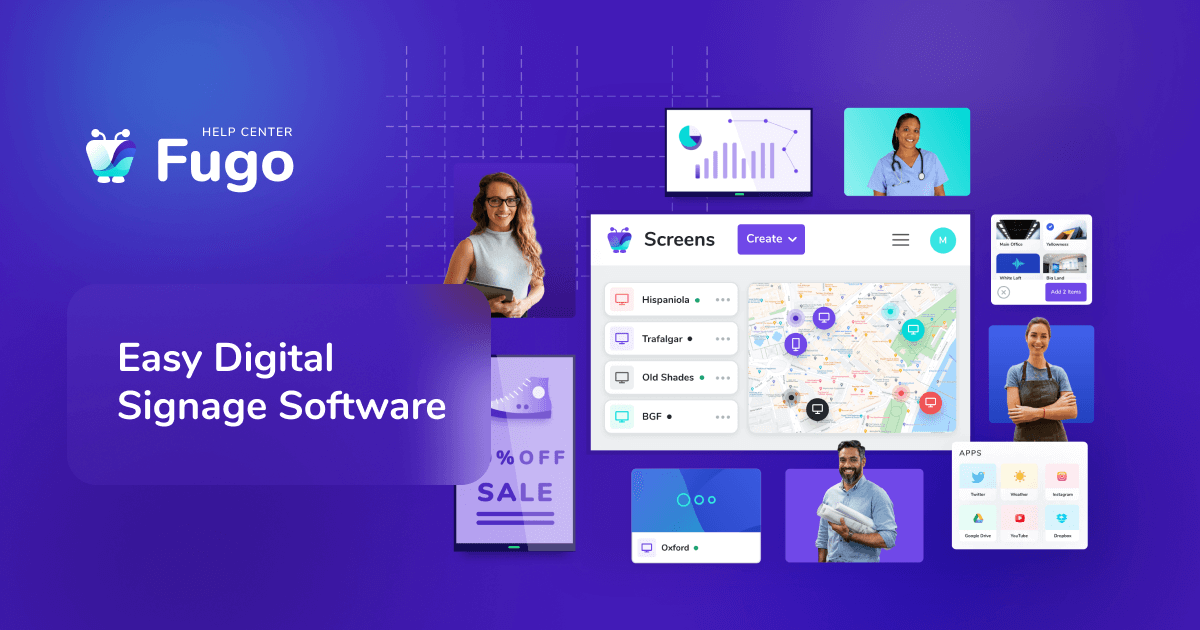
What matters for buying hardware that actually survives in the field
When it comes to Android hardware for digital signage, it’s not just about picking the cheapest device. Sure, consumer devices might be a steal (and appropriate for some use cases), but they’re not built to run 24/7, and that’s where the problems start.
Overheating, power issues, and a short lifespan are all part of the cost you’re not seeing upfront.
Consider the hidden costs of consumer hardware
What separates commercial digital signage hardware from consumer devices isn't marketing. It's fundamental engineering differences:
Thermal controls
- Commercial hardware is designed for continuous use, with features like heat sinks, ventilation, and durable components to prevent overheating. Consumer devices, however, often sacrifice these for sleeker designs. This leads to thermal throttling - where performance drops due to excessive heat - and earlier-than-expected component failure when used for extended periods.
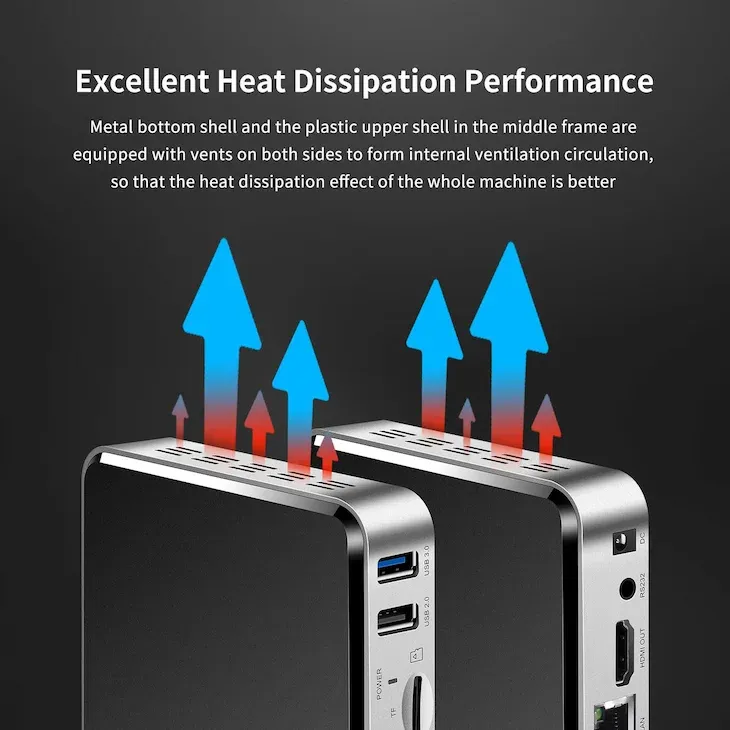
Power handling
- Commercial devices have power management systems that can handle the fluctuations common in public and business environments. Consumer devices are built with home-use power stability in mind, which makes them prone to malfunction when faced with power surges or outages.
Warranty & support
- The one-year warranty of consumer devices doesn’t cut it for businesses that need uptime. Commercial-grade products come with 3-5 year warranties, advanced replacement options, and customer support tailored to business needs.
These differences matter most in environments where devices operate continuously and access for maintenance is limited or costly. A restaurant with Android displays in customer-facing areas can't afford screens freezing during peak service hours, making commercial-grade reliability worth the investment.
Think ahead about form factor for your environment
The physical design of Android signage devices significantly impacts installation options and management needs. Port selection, connectivity options, and mounting capabilities often prove just as important as processing specs.
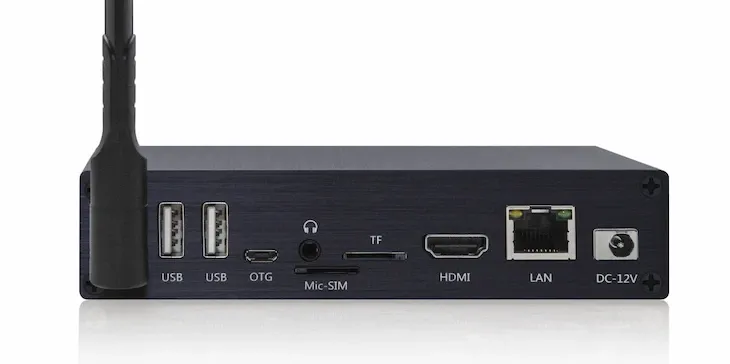
- Public spaces: For areas with heavy foot traffic or where security is a concern, integrated System-on-Chip (SoC) displays are designed to minimize tampering risks and offer a clean, professional look.
- Connectivity: If you’re in an area with weak Wi-Fi, look for devices with dual-band Wi-Fi and external antenna options, or devices that can switch between networks for a more reliable connection.
- Peripherals: Interactive kiosks and product displays often require more USB ports for touchscreens, sensors, and peripherals. Be sure the device can handle the peripherals you plan to use before deployment.
Consider what kind of performance your content demands
Matching hardware performance specs to content requirements prevents headaches down the road. Keep these tips in mind:
- Simple playlist content with static images and limited animations runs effectively on basic hardware with 2GB RAM and entry-level processors. This level of hardware works well for straightforward menu boards or informational displays.
- Multi-zone layouts combining video, social feeds, and dynamic data require more robust processing capabilities. Displays showing departmental KPIs alongside company news and video content need mid-tier hardware with 4GB RAM and more powerful GPUs to maintain smooth playback.
- Interactive applications with touch input and responsive design elements demand the highest performance specifications. Product explorers allowing customers to browse options and customizations require top-tier hardware with 6GB+ RAM and premium processors to maintain responsive interaction.
From our testing, the Chromecast with Google TV kept up with zoned content & data display
Top Android hardware picks for digital signage in 2025
Based on real-world performance testing and reliability data, here are our top recommendations for various deployment scenarios.
Budget friendly consumer Android media players
These devices offer the most accessible entry point for digital signage while still delivering solid performance for most content types.
- Google TV Streamer (4K) - $99.99
The latest Google streaming device has become surprisingly capable for basic signage. With Android 14, 4GB RAM, and 32GB storage, it handles multi-zone layouts and demanding content better than you'd expect from its compact form factor. Best for locations where screens are easily accessible and run 8-10 hours daily. - MECOOL KM2 Plus - $87.99
This Android TV 12 box provides excellent value with dedicated Ethernet, HDMI output, and support for 4K HDR content. The 2GB RAM and 16GB storage handle standard signage tasks efficiently, though complex dashboards may push its limits. Its set-top box design offers better cooling than streaming sticks for moderate usage environments. - Nvidia Shield TV Pro - $149.99
The premium option in consumer Android players, with 3GB RAM and robust processing power that easily handles demanding content. Its Android TV 11 implementation is rock-solid, with gigabit Ethernet ensuring reliable connectivity. Worth the higher price for situations requiring reliable performance without stepping up to commercial hardware.
All-in-one Android smart TVs
For deployments where simplicity and clean installation matter, these Android TVs eliminate the need for external players.

- Xiaomi TV P1E - $300-$500
This very affordable Android TV 10 display (available in 32" to 65" sizes) offer exceptional value for budget-conscious deployments. With reliable 8-10 hour daily operation capabilities, they're particularly well-suited for markets in Eastern Europe and Asia where cost-efficiency is paramount without sacrificing basic functionality. - Sony BRAVIA 3 Series TVs - $499-$1,300
Available across a wide size range (43" to 85"), these Google TV-powered displays deliver reliable 4K signage performance at budget-friendly price points. Their 8-10 hour daily operational rating makes them ideal for standard business deployments that don't require extended runtime. And the clean interface and reliable performance make them a safe choice for organizations needing dependable displays without enterprise pricing. - Sony BRAVIA X77L Series - $550-$1,100
Available in sizes from 50" to 85", these Google TV-powered displays offer solid entry-level signage capabilities. They handle 8-12 hours of daily operation reliably, making them suitable for retail storefronts, waiting rooms, and office environments where 24/7 operation isn't required.
Professional SoC displays
When uptime is critical and maintenance access is limited, professional displays with built-in Android deliver dependable performance over longer operational periods (think 16/7 or 24/7 working hours).
Note that these commercial-grade units are usually only available through authorized distributors & system integrators, rather than standard retail channels like your local big box store.
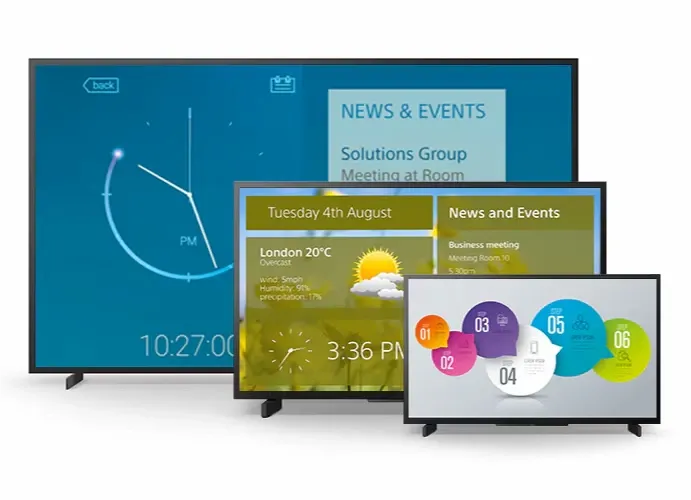
- Sony BRAVIA BZ30L Series - $1,000-$3,000
These 24/7-rated professional displays come with Android TV OS built in, eliminating the need for external players while providing enhanced reliability for always-on environments. Available in sizes from 43" to 85", they're ideal for retail, corporate lobbies, and public spaces requiring continuous operation. - Sony BRAVIA BZ40L Series - $1,500-$4,000
The step-up model adds significantly higher brightness levels (up to 700 nits), making it perfect for window-facing installations or brightly lit environments where content visibility is critical. The enhanced processor handles complex content while maintaining 24/7 reliability.
What matters for buying software - your content management layer
You've got shiny new Android hardware installed. The screens look great powered on. Then reality hits: How exactly do you get content on these things? How do you schedule different content for mornings versus afternoons? And when something inevitably breaks at your busiest location, how will you know before angry calls start coming in?
This is where many Android signage projects crash and burn - when businesses discover that hardware without proper management software is just expensive digital picture frames.
The difference between professional digital signage and glorified PowerPoint presentations isn't the screens - it's the software layer that controls them.
Ditch USB sticks & manual updates
Ever tried updating content on multiple screens using basic media players? It usually goes something like this:
- Create content on your computer
- Save to USB sticks (one for each location)
- Visit each screen to plug in the USB
- Hope the content actually plays correctly
- Repeat every time anything needs changing
This approach collapses spectacularly once you have more than a couple of screens or need frequent updates.Without a content management system (CMS), you're left manually updating playlists, unable to schedule content by time of day, and lacking the ability to monitor your screens remotely.
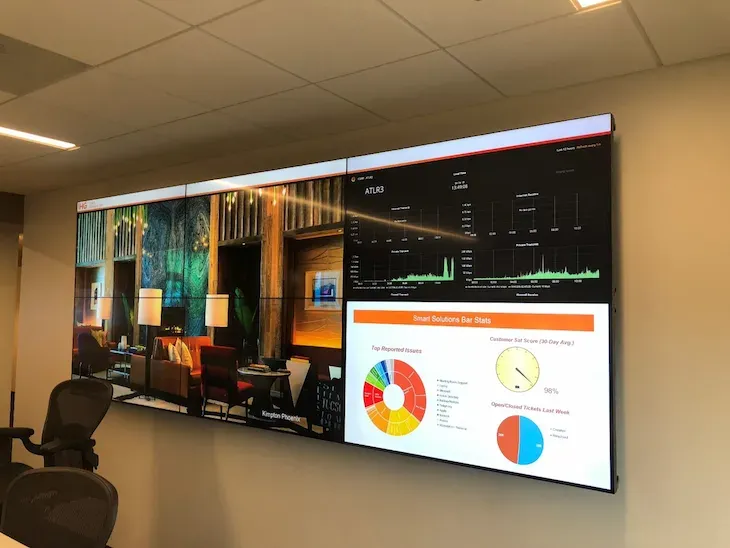
The real solution is a CMS. With a CMS, you can remotely manage, schedule, and update content across all your screens, making content delivery streamlined and scalable, without the need to physically handle each device.
What professional CMS platforms do differently
They handle scheduling automatically. Your restaurant's breakfast menu disappears precisely at 11:00 AM, switching seamlessly to lunch offerings without staff lifting a finger. No more embarrassed "sorry, we're not serving that anymore" conversations.
They maximize screen real estate. Split your display into zones showing different content simultaneously – videos in one area, social feeds in another, and today's specials in a third. One screen, multiple messages, greater impact.
They tell you when things break. Get alerts the moment a screen goes offline instead of finding out when a customer points out your blank display. Fix issues remotely before most people even notice a problem.
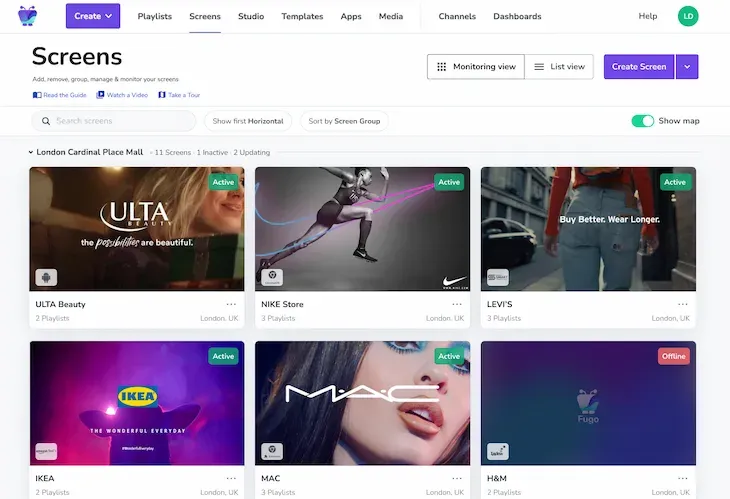
They prove what's playing. Generate reports showing exactly what displayed when, perfect for compliance requirements or confirming promotional campaign execution across locations.
Top digital signage platforms in 2025
With so many digital signage platforms available for Android, finding the right match means looking beyond marketing claims to understand each platform's true strengths and limitations.
These are some of the popular options on the market:
Fugo
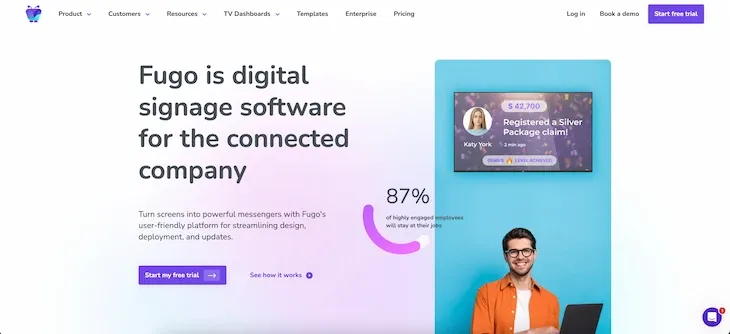
Fugo differentiates itself by focusing on what screens should actually do in business environments: display meaningful, real-time data that drives decisions.
And Its Design Studio enables multi-zone layouts that combine traditional media with live data feeds from Salesforce, Power BI, HubSpot, Tableau, and more.
The platform particularly shines for internal communications and operational dashboards where business metrics matter more than simple promotional content.
Is it supported on Android? Yes ✅
What Fugo users say
“Fugo is a genuine breath of fresh air with bleeding-edge technology that’s really changing the way we present data in the business.”
— Benjamin D., Integrations Lead - via Capterra
| What they love (Pros) | What they don’t love (Cons) |
|---|---|
| ✔ Seamless integration with spreadsheets and BI tools | ⚠️ No mobile app or offline content editing |
| ✔ Reliable for internal comms across distributed teams | ⚠️ Limited design customization for visual-heavy use cases |
| ✔ Affordable pricing with clear plan tiers | ⚠️ Smaller template library compared to visual-focused platforms |
Yodeck

Yodeck stands out for its wallet-friendly pricing structure, making it attractive for budget-conscious businesses and first-time signage users. It handles the basics competently – scheduling playlists, simple layouts, remote updates – but shows its limitations when you need sophisticated data integration or interactive content.
Think of it as the entry-level option that works until your needs grow more complex.
Is it supported on Android? Yes ✅
What Yodeck users say
“Yodeck was fairly simple to set up, and once done, I uploaded photos and adverts for my restaurant. It’s worked as expected with no major issues. I especially appreciate the ability to modify screens remotely from home, saving me from needing to visit the restaurant. Everything has been running smoothly, with 100% uptime.
However, the initial setup was tricky - I had some trouble with the Raspberry Pi not booting up and issues with SSH access.
— Aaron H., Web Developer – via Capterra
| What they love (Pros) | What they don’t love (Cons) |
|---|---|
| ✔ Efficient remote screen management | ⚠️ Connectivity challenges – Some users report Wi-Fi issues, requiring Ethernet for stable connections |
| ✔ Seamless media deployment – Pre-configured devices and easy media management | ⚠️ Occasional troubleshooting difficulties – Users have struggled with app integrations and diagnosing problems |
| ✔ Versatile digital signage solution – Intuitive, customizable templates that enhance brand visibility | ⚠️ Challenges with Raspberry Pi setup – Some users faced issues during initial setup and had to reflash units |
Optisigns
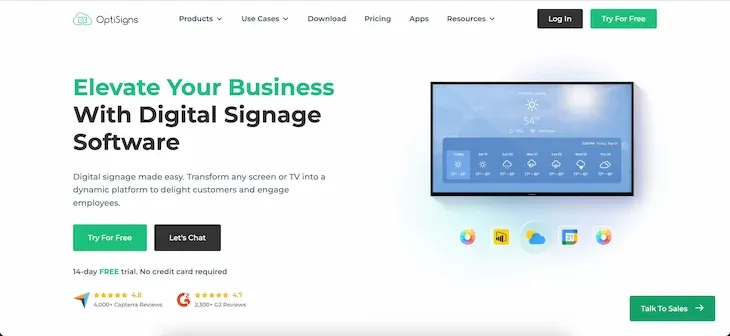
OptiSigns positions itself as the generalist of digital signage - a jack-of-all-trades that does many things adequately without specializing in any particular area. Its extensive template library and accessible content tools make it appealing for marketing teams wanting to create visually appealing displays.
But this generalist approach has drawbacks when you need specialized capabilities. The platform offers some dashboard tools, but lacks the depth needed for serious data integration. When your requirements evolve beyond basic displays to include real-time business data or seamless integration with tools like Salesforce or HubSpot, you'll quickly encounter its limitations.
Is it supported on Android? Yes ✅
What OptiSigns users say
“OptiSigns is versatile and easy to use. The experience has been positive and pain-free. It is very easy to set up and maintain. I like how configurable the permissions are, allowing each team to manage their screens individually while I can control them as an admin.”
— Peyton F., IT Support Specialist – via Capterra
| What they love (Pros) | What they don’t love (Cons) |
|---|---|
| ✔ Seamless and efficient setup – Most users find the setup process quick and simple, enhancing operational efficiency | ⚠️ Inconsistent player performance – Some users experience issues with app compatibility and playback inconsistencies |
| ✔ Convenient remote control – Remote management capabilities allow users to control displays easily across multiple locations | ⚠️ Limited content suggestions for specific use cases – Users needing specific content like PowerBI integration note a lack of relevant templates |
| ✔ Effective internal communication tool – Many users appreciate its ability to disseminate consistent and engaging messages to employees | ⚠️ Limited specialized template options – The available templates tend to focus on retail or general purposes rather than niche applications like data visualization |
Screencloud
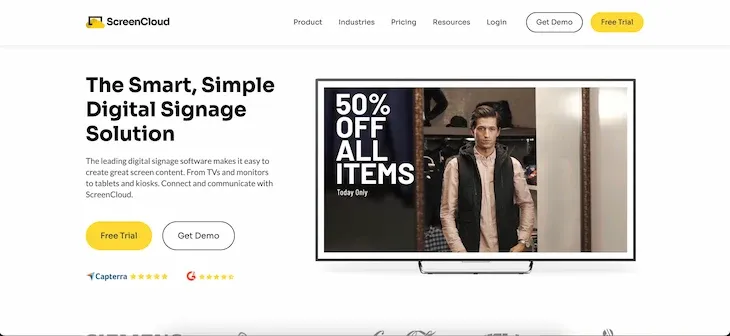
ScreenCloud went all-in on the enterprise market by developing its own operating system (ScreenCloudOS) specifically for signage. This creates a tightly controlled ecosystem with security features that appeal to corporate IT departments.
The trade-off comes in pricing – expect to pay premium rates, particularly for advanced features that often sit behind higher subscription tiers.
Is it supported on Android? Yes ✅
What ScreenCloud users say
“Overall we're really happy with ScreenCloud. It works really well, has no downtime, is easy to use, and is very cost-effective for all its features. The interface is laid out well and if you have doubts about what it looks like, there's a preview option to see how it will look.
However, there are a lot of features we don’t use, and I wish we didn’t have to pay for those. We only have 5 screens and show basic picture content. Channels and playlists seem a little redundant for our setup.”
— Nate G., Network Engineer – via Capterra
| What they love (Pros) | What they don’t love (Cons) |
|---|---|
| ✔ Seamless content publishing – Easy to quickly deploy media, photos, and videos across screens | ⚠️ Overwhelming features for small users – Some users find the tool’s depth unnecessary for their needs, paying for features they don’t use |
| ✔ Flexible media integration – Supports popular apps like Dropbox and Google Drive, alongside computer files | ⚠️ Redundancy in channels vs playlists – Some users find the system’s structure redundant for their simple setups |
| ✔ Preview feature for content layout – Helps users visualize and ensure content appears as intended on the screen | ⚠️ Lack of analytics – No built-in analytics to track performance or content engagement |
How to set up your Android player with a digital signage CMS
One of the great things about Android is how easy it makes setting up your digital signage system. With a familiar user interface and straightforward steps, it’s a user-friendly experience - regardless of the player or CMS you’re using. While the process may vary slightly, here’s a general workflow that applies to most setups:
- Connect your player to the screen: If you're using an external Android player, connect it via HDMI and switch to the corresponding HDMI port on your screen. For smart TVs with built-in Android, this step isn’t necessary.
- Connect to the internet: Use Wi-Fi or Ethernet, depending on what your device supports, to get your player or smart TV online.
- Download the digital signage player app: Go to the Google Play Store, search for your digital signage app (e.g., Fugo), and install it.
- Pair with your CMS: Open the app and follow the prompt to connect it to your CMS. For Fugo, simply enter the pairing PIN into the CMS in your browser to sync everything.
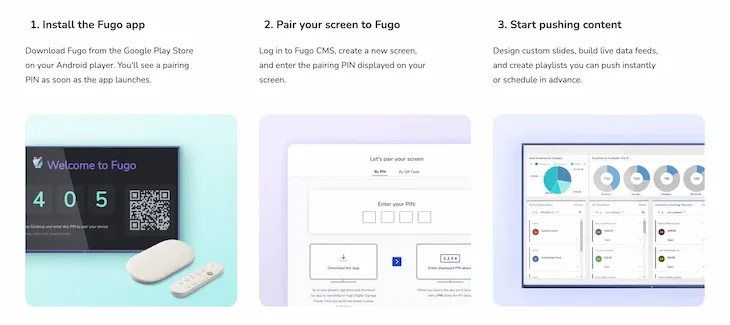
Deploy content that won't break your screens
Ever created the perfect digital masterpiece only to watch it stutter, freeze, or crash when deployed to your actual screens? You're not alone. The gap between creative ambition and Android hardware reality ruins countless signage deployments.
Professional CMS platforms like Fugo handle much of this complexity automatically - compressing files for optimal playback, setting Android-optimized video codecs, and caching content locally on players for offline fallback.
But understanding these fundamentals helps you create content that works seamlessly in the field:
- Ditch the heavy animations
Those continuously moving backgrounds that looked amazing in Adobe After Effects? They're processing killers on actual signage players. Save animation for what matters, not decorative elements. - Choose smarter file formats
Swap bloated JPEGs for WebP images (30-40% smaller) and use H.265/HEVC video compression. Your network bandwidth and playback performance will thank you. - Know your hardware tiers
That 4K video wall with live data integration might run perfectly at headquarters on premium hardware, but will crash constantly at satellite locations. Create content variants optimized for different device capabilities. - Plan for offline scenarios
While good CMS platforms like Fugo handle caching automatically, ensure your content strategy includes offline-friendly content that doesn't rely on real-time data for locations with spotty connectivity. - Beware the multi-video trap
Multiple simultaneous video zones are processing nightmares. If you must use them, ensure your hardware exceeds minimum specs by a healthy margin.
The Android signage market is finally growing up
2024 marked a turning point for Android signage. Consumer tech giants Google and Amazon recognized digital signage as a distinct category deserving specialized hardware, while platform-level improvements finally solved the reliability issues that kept Android out of mission-critical deployments.
Budget options that actually work
This convergence has created viable signage solutions across wider budgets and use cases. Google's upgraded TV Streamer now handles basic deployments that would have crashed its predecessor, offering legitimate sub-$100 signage capability for coffee shops and small retailers.
And Amazon's purpose-built signage stick bridges consumer and commercial markets with specialized features like improved power management and simplified deployment workflows.
Find deep dives here 👇

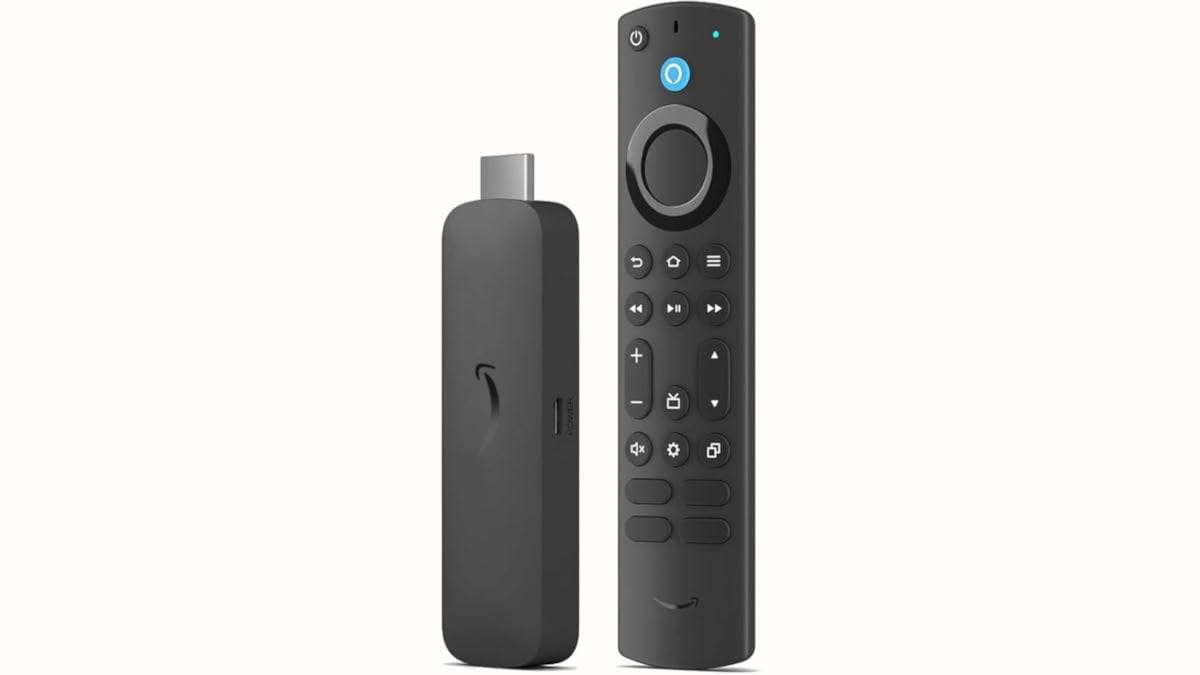
Reliability problems solved
Behind-the-scenes Android 13/14 improvements - better background process management, always-on operation profiles, and zero-touch enrollment - have eliminated the mysterious crashes and maintenance headaches that plagued earlier deployments.
Make your project simple with Fugo
Android-based digital signage gives you flexibility and control at an affordable price. Whether you're outfitting a few screens or scaling up, it all comes down to the right hardware and the right CMS to make everything run smoothly.
Ready to stop wasting time on unreliable setups? Fugo's platform gives you powerful management tools for Android displays, so you can focus on what matters: delivering content that engages and informs.
Start your free trial with Fugo and see how easy it can be to take control of your digital signage.
